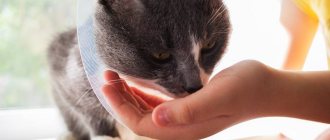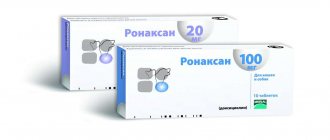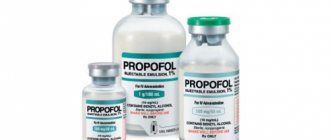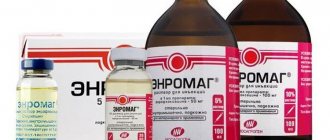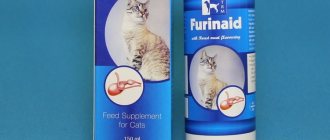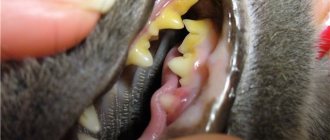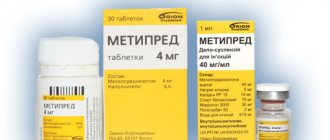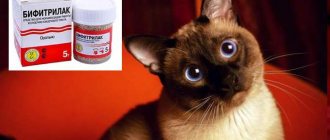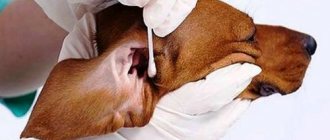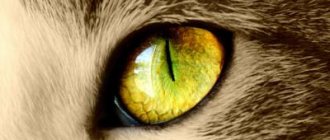6231Pavel
Animals most often have excellent immunity and rarely get sick, but there are exceptions. If your cat begins to sit down frequently and go to the toilet in small portions, then it’s time to visit a veterinarian. Most likely she has cystitis. In this case, the doctor will prescribe Furadonin for the cat, which will help cope with the disease.
This drug is also used for other diseases of the genitourinary system. Furodonin will bring your cat's health back to normal, the main thing is to follow all the veterinarian's recommendations.
© shutterstock
Pharmacological action of furadonin when administered to animals
Pharmacological action of nitrofurantoin
- bacteriostatic antibacterial effect, but can also have a bactericidal effect, which depends on its concentration and sensitivity of bacteria. The exact mechanism of action of nitrofurantoin continues to be determined, but it is believed that the drug inhibits various enzyme systems in bacteria, including acetyl coenzyme A. In an acidic environment, the antibacterial activity of nitrofurantoin increases.
According to the instructions for use, furadonin is active against a number of gram-negative and some gram-positive microorganisms, including strains: E. coli, Klebsiella, Enterobacter, Enterococci, Staphylococcus aureus and epidermidis, Cltrobacter, Salmonella, Shigella and Corynebacterum. Furadonin exhibits little or no activity against most strains of Proteus Serratia or Acinetobacter; against Pseudomonas sp. Nitrofurantoin has no activity.
Features of the disease
The disease has no age-related characteristics - both old and young animals, including puppies, are affected. A separate risk group is formed by small breeds and short individuals (dachshunds, for example). Bitches get sick somewhat more often than males due to the anatomical features of the structure of the genitourinary system.
In general, dogs get sick less often than cats, but have a more pronounced clinical picture.
It is very important to determine the exact cause of the disease, because only symptomatic therapy is a guarantee that the pathological condition will return, and next time it will manifest itself many times more strongly.
Symptoms of cystitis in dogs are acute and chronic. Chronic cystitis is a condition that develops against the background of some other primary disease. Its symptoms are diluted with clinical signs of another pathology, so it becomes difficult to make an accurate diagnosis. In acute cases, the symptoms are pronounced, and there are no difficulties with preliminary diagnosis.
According to its manifestations, bladder inflammation in dogs is classified into:
- catarrhal (the urine is cloudy, and protein is detected in the analysis);
- hemorrhagic (obvious presence of blood);
- dystrophic (externally the urine is practically unchanged, but tests reveal epithelial cells);
- purulent (the name speaks for itself - the presence of pus and an unpleasant odor leave no doubt about the form of the disease).
Use of furadonin for animal therapy
According to the instructions for use, the indications for nitrofurantoin in veterinary medicine are quite broad. It is considered an antiseptic in the treatment of urinary tract diseases in animals and is prescribed primarily to dogs and cats, but also to horses for the treatment of lower urinary tract infections caused by susceptible bacteria. The drug is not effective for the treatment of cortical renal abscesses, peripheral abscesses, or other systemic infections in animals.
general information
According to the official instructions, the antibacterial drug Furadonin contains an active component - nitrofurantoin, the action of which is aimed at preventing the proliferation and death of pathogenic microorganisms.
The medicine is sold in the form of tablets intended for oral administration. For the treatment of infectious diseases in cats, Furadonin should be purchased in a dosage of 0.05 g. The activity of the antibiotic extends to salmonella, E. coli, streptococcal infection and many other pathogenic microorganisms. Nitrofurantoin acts directly on pathogenic agents: it disrupts the conductivity of their membranes and interferes with the synthesis of proteins. After the dose is taken, the active substance is absorbed into the gastrointestinal tract and excreted by the kidneys. The active component penetrates the placental barrier and into milk.
Pharmacokinetics of furadonin in animals
Pharmacokinetics of nitrofurantoin in animals: the drug is rapidly absorbed from the gastrointestinal tract, the presence of food enhances the absorption of the drug. The macrocrystalline form of the drug is absorbed more slowly with less gastrointestinal upset. Due to the slow absorption of nitrofurantoin, its level in the urine can be maintained for a long time.
Furadonin does not reach therapeutic levels in the systemic circulation in cats and dogs
, since after absorption there is rapid elimination. Nitrofurantoin is approximately 20-60% bound to serum proteins. The maximum concentration is observed 30 minutes after administration. The drug penetrates the placenta; only a minimal amount of furadonin is found in the milk of animals.
About 40-50% of the drug is eliminated unchanged in animals in the urine by glomerular filtration and tubular secretion. Part of nitrofurantoin is metabolized mainly in the liver. The elimination half-life in a person with normal renal function averages 20 minutes.
Drug Stop-cystitis
This is a whole series of drugs, which is represented by three herbal complex products: Stop-cystitis in tablets and suspensions and Stop-cystitis bio, also in suspension (what to give a dog for cystitis from the above is decided by a veterinarian). The drugs very quickly normalize the animal’s condition, eliminating the symptoms of the disease. The “bio” form allows you to constantly monitor the condition of the urinary system as a preventative measure. Stop-cystitis, in addition to herbal components, has medicinal components in the list of components that explain its action.
Functions of the drug: antimicrobial, antiseptic, diuretic, anti-inflammatory, saluretic (removal of sand and stones from the bladder).
Stop-cystitis (in suspension – up to 320 rub./50 ml)
Available in various volumes (maximum 150 ml). For individuals up to 10 kg, the daily dose is 4 ml, divided into 2 doses of 2 ml. If the weight exceeds 10 kg, then the daily dose increases to 6 ml, and the number of doses can be 2 or 3 (3 ml or 2 ml at a time, respectively). The duration of the course is determined by the veterinarian, paying attention to the severity of the pathology, concomitant treatment and course of the disease. For the purpose of prevention, 1 ml is given once a day for the 1st week.
Stop-cystitis (in tablets – up to 290 rubles/20 tablets)
Give 1 tablet twice a day to dogs weighing up to 10 kg and 1.5 tablets if the weight exceeds 10 kg. For the purpose of prevention - once. Course 5-7 days. The tablet is placed on the base of the tongue or given simultaneously with any food convenient for administering the medicine.
Stop-cystitis bio (up to RUB 350/50 ml)
This is control and improvement of the functioning of the entire urinary system. For periodic course intake. Dosage: unless otherwise indicated by the veterinarian, then give 2 ml of the suspension to dogs weighing up to 10 kg and 3 ml if more than this weight 1-2 times a day. Duration: one week during exacerbation. And once a day, 1 ml for one month for control normalization of the condition.
Side effects
Not noted. In very rare cases, allergic manifestations were recorded, which disappeared after stopping the drug.
Contraindications
There are no special contraindications, with the exception of individual reactions to the constituent components.
special instructions
Suspensions must be shaken before use. It is important not to miss doses - both in tablets and in suspensions, because the effectiveness of the action decreases. If a dose is missed, the next one should be taken at its scheduled time without doubling the volume.
Contraindications for the use of furadonin in cats, dogs and other animals
According to the instructions for use, nitrofurantoin is contraindicated in animals with kidney damage, since in this case the effectiveness of the drug is sharply reduced and the likelihood of developing a toxic effect increases. Furadonin is also contraindicated in animals that are hypersensitive to it.
In humane medicine, nitrofurantoin is contraindicated when labor is approaching and in newborns, since hemolytic anemia may develop due to underdevelopment of the enzyme system. The safety of using furadonin in early pregnancy in animals has not been established. It is assumed that nitrofurantoin can cause infertility in male dogs, therefore, in these cases, the effectiveness of drug treatment should be carefully correlated with possible side effects.
When is it prescribed?
The disease is accompanied by an inflammatory process.
Veterinarians prescribe Furadonin to cats who have been diagnosed with the following pathologies:
- isolation of bacteria in urine;
- inflammation of the bladder, urethra;
- acute form of cystitis;
- infection of the urinary system;
- inflammatory process in the kidneys of bacterial etiology;
- purulent inflammation of the perinephric tissue.
Learn about essential antimicrobials in animals
- Trichopolum in veterinary medicine
- Instructions for the use of the antibiotic Baytril in animals
- Use of metronide in veterinary medicine
- Use of ceftriaxone for animals
- Use of Metrogyl in animals
- Instructions for doxycycline in animals
- Metronidazole (Metronidazole) for animals (instructions for use in veterinary medicine, doses, indications and contraindications)
- Atovaquone (ATOVAQUONE)
- Azithromycin for veterinary use
Cystitis in a cat - 12 answers from doctors to a question on the Ask a Doctor website
Elizaveta, St. Petersburg
March 16, 2019
The cat is 12 years old and has had ICD since he was 5 years old. 7 years ago I had a urethrostomy operation. Since then he has been eating Hill's c/d food. Every six months to a year the cat developed cystitis (blood in the urine, screaming when urinating), no-spa, stop cystitis and cyston helped. In 2020, the cat had prolonged cystitis with urine leaking down his hind legs (the cat was with relatives for 4 months). Cystitis was cured with Sinulox+stop-cystitis+renal. At the moment, my cat and I are already living abroad. 3 months ago the cat started crying in the toilet again and pushing. I gave Cyston for 1 month. Did not help. I only had amoxicillin in stock. I took a course of antibiotics for 8 days. There was no effect either. The cat began to leak urine heavily, and again all of his hind legs were covered in urine. Next, I went to the vet. The doctor prescribed only the antibiotic cephalexin + antispasmodic. I considered that it would be inappropriate to carry out the course again with an antibiotic without an antibacterial drug. And it is impossible to go and buy such drugs at the pharmacy to combat cystitis without a prescription.
At home I found streptocide.
For 5 days I gave Streptocide. The effect appeared on the 5th day, urine stopped leaking. But the drug, apparently, was “heavy”; the cat became very ill. I stopped the course. And after 3 days the leakage resumed. About 2 weeks have passed. Now I am taking a course of the antibiotic Amoxicillin (about 50 mg, 2 times a day, today is the 6th day) and Furadonin 25 mg 2 times a day, the 6th day). Also Karsil for the liver. But, unfortunately, there is no effect, the cat’s urine leaks uncontrollably, leaving a stain where he sits. Of the Russian drugs, Biseptol is available. I haven't started giving it yet. Please tell me the Latin names of the drugs, dosage and duration of use, which I could show to local doctors and they would write a prescription. The cat has lost a lot of weight. Hill"ss/d refuses food, but continues to eat Hill"sc/d. Thanks a lot! Chronic diseases:
chronic cystitis, had urethrostomy
The question is closed
No reward
Drug interactions with furadonin
According to the label, uricosuric drugs such as sulfinpyrazone or probenecid may inhibit renal excretion of nitrofurantoin
and increase its toxicity in dogs, cats and other animal species, as well as reduce its effectiveness in the treatment of urinary tract infections.
Nitrofurantoin may antagonize the antimicrobial activity of fluoroquinolones (eg, enrofloxacin, ciprofloxacin), so their combined use in veterinary medicine is not recommended.
Antacids containing magnesium trisilicate may inhibit the absorption of furadonin when administered orally. Food and anticholinergic drugs may increase the bioavailability of nitrofurantoin when administered orally. The effect of furadonin on laboratory parameters can lead to false-positive results when determining glucose in urine when using a test with copper sulfate solutions (Benedict's reagent, Clinitest®). Nitrofurantoin has no effect on the determination of urine glucose using the glucose oxidase method.
Nitrofurantoin may cause a decrease in blood glucose and an increase in serum creatinine, bilirubin, and alkaline phosphatase in all animal species.
Possible restrictions
The drug may cause allergies.
Before prescribing Furadonin to cats, the veterinarian must make sure there are no contraindications. It is forbidden to use the medicine for cystitis and other infectious pathologies in pets who are allergic to the antibiotic. You should not resort to therapy with Furadonin tablets for cats with anemia, diabetes mellitus, impaired renal function, and hepatitis. In addition, the medication is contraindicated for heart problems, deficiency of B vitamins in the body, and in the absence of urine entering the bladder. Furadonin is not used for the treatment of cats if they are less than 6 weeks old or are pregnant or nursing kittens.
Doses of furadonin
Nitrofurantoin is widely used in dogs:
For drug-sensitive bacterial urinary tract infections:
- dosage for dogs: 4 mg/kg per os every 6 hours (Osborne and Lulich 1987);
- Furadonin is dosed in dogs
for recurrent infectious diseases of the urinary tract: standard dose 4 mg/kg per os every 8 hours; prophylactic dose of 3–4 mg/kg per os every 24 hours (to be given in the evening immediately after urination and just before bedtime) (Polzin and Osborne 1985); - For dogs, nitrofurantoin is used in a dosage regimen of 4 mg/kg per os 3 times a day (Morgan 1988).
Adverse reactions
A potent drug based on nitrofurantoin, when used correctly and regularly, is well tolerated and guarantees positive treatment success. If you neglect the recommendations of veterinarians, then the chance of developing side symptoms in pets increases significantly. In this case, the cat may experience nausea, vomiting, frequent loose stools, changes in blood composition, and drowsiness. In addition, anaphylactic shock, skin itching, pulmonary fibrosis, cough, refusal to feed, shortness of breath and joint pain may occur.
In exceptional cases, while taking Furadonin, cats experience vaginal discharge and, within the first hour after drinking a dose of the antibiotic, chills and fever. If signs of a negative reaction of the animal’s body to antibacterial therapy appear, it is necessary to suspend treatment and contact a veterinarian. The doctor will adjust the dosage or replace “Furadonin” with a drug similar in action, for example, “Furagino”, “Stopidar” or “Furazidin”.
Application of furadonin to cats:
For drug-sensitive bacterial urinary tract infections:
- furadonin is prescribed to cats at a dose of 4 mg/kg
per os every 6 hours (Osborne and Lulich 1987); - for recurrent infectious diseases of the urinary tract in cats: standard dose of nitrofurantoin 4 mg/kg per os every 8 hours. Prophylactic dose for cats: 3-4 mg/kg per os every 24 hours (to be given in the evening immediately after urination and just before bedtime) (Polzin and Osborne 1985).
Instructions for the use of furadonin in horses For drug-sensitive bacterial urinary tract infections:
- furadonin is dosed in horses at the rate of 2.5-4.5 mg/kg
per os 3 times a day (Robinson 1987); - the horse dose is 10 mg/kg per os daily (Huber 1988a).
Application and dosage of the drug
To treat an animal, it is important to determine the correct dosage.
Did you know? The most popular cat breed today is the Persian, followed by the Maine Coon, followed by the Siamese.
The veterinarian does this based on:
- type of disease;
- cat's condition;
- her age (preferably older than 1 year);
- body weight.
On average, 5-10 mg per 1 kg of weight is prescribed. At the same time, the maximum doses range from 300 mg at a time and 600 mg per day. The dose prescribed by the veterinarian is divided into several portions throughout the day, feeding them to the pet along with the next meal.
Sometimes cats refuse to eat the medicine. Then you have to give them the drug forcibly, placing the tablet on the root of the tongue, and then slightly squeezing the mouth, thereby causing a swallowing reflex. The recommended duration of therapy is 7 days, however, in individual cases, the veterinarian may indicate a different period.

